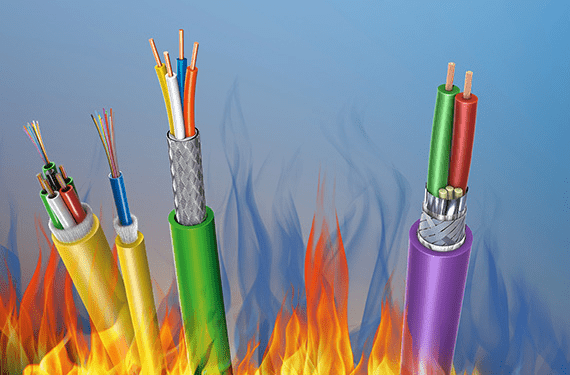When a short circuit occurs or there is an open fire nearby, the commonly used XLPE power cables will be caused by flames, and the fire will be more serious, especially when multiple cables are laid in a concentrated manner. Therefore, it is very important to take reasonable fire protection measures for cables to prevent the spread of cable fires.
Fire-resistant cable is a cable that can maintain normal operation for a certain period of time under specified flame conditions, or a cable that can maintain the integrity of the line under burning conditions. It is stipulated in the GB/T19666-2005 standard as follows: under the rated voltage of 0.6/1.0KV and below cables, the fire temperature is 750 50 ℃, the fire time is 90min, the cooling time is 15min, the 2A fuse is continuous or the indicator light is not Bright.
1. Selection of conductor material and conductive core structure
The melting point of the aluminum conductor is 685°C, and the fire temperature of the refractory cable should reach 750 50°C according to GB/T 19216. Obviously, the aluminum conductor cannot be used as a fire-resistant cable; the melting point of copper is above 1000°C, so it can be used as a fire-resistant cable. conductor.
Copper wires with a cross-section of 1.0mm2 and below do not melt at high temperatures, but because the wire core is too thin, it is easy to break due to local overheating and slight external influence, and lose the normal power-on function. Therefore, 1.0mm2 and below are not recommended. The copper wire is used as a fire-resistant cable.
The large-section cable fan-shaped core conductor is not easy to be used as a fire-resistant cable, and the circular core conductor is suitable for use as a fire-resistant cable. Because the surface of the circular structure is smoother than that of the fan-shaped structure, the force of the mica tape is relatively uniform, and the mica tape will not be damaged, and the circular structure saves the mica tape than the fan-shaped structure, and the cost is low.
2. Selection of mica tape
The refractory temperature of synthetic mica is higher than that of phlogopite. In actual production, the refractory mica tape can be selected according to the customer’s requirements. Considering the safety of the refractory cable and ensuring the quality stability of the refractory cable, it is recommended to use synthetic mica.
3. Selection of insulating materials
The commonly used insulating materials for fire-resistant cables are mostly PVC, PE, XLPE, etc., but the effect of using PE and XLPE is better than PVC, because at a high temperature of 750-50 °C, the insulating material of the cable has long been burned and does not exist, but different insulating materials The residual materials after combustion have different effects on mica tapes.
The main components of PVC are PVC resin and CaCO3, which adhere to the outside of the mica tape according to its combustion mechanism. The mixture of its burning solid residues, CaO and Cacl2, is in a relatively stable state and adheres to the outside of the mica tape. Internal stress is generated, the mica tape is squeezed, the mica tape is damaged, and the refractory performance is affected.
4. Selection of auxiliary materials
As auxiliary materials for fire-resistant cables, although the tape and filling are not key materials, they are selected according to the principle of generating the least residue after combustion.


